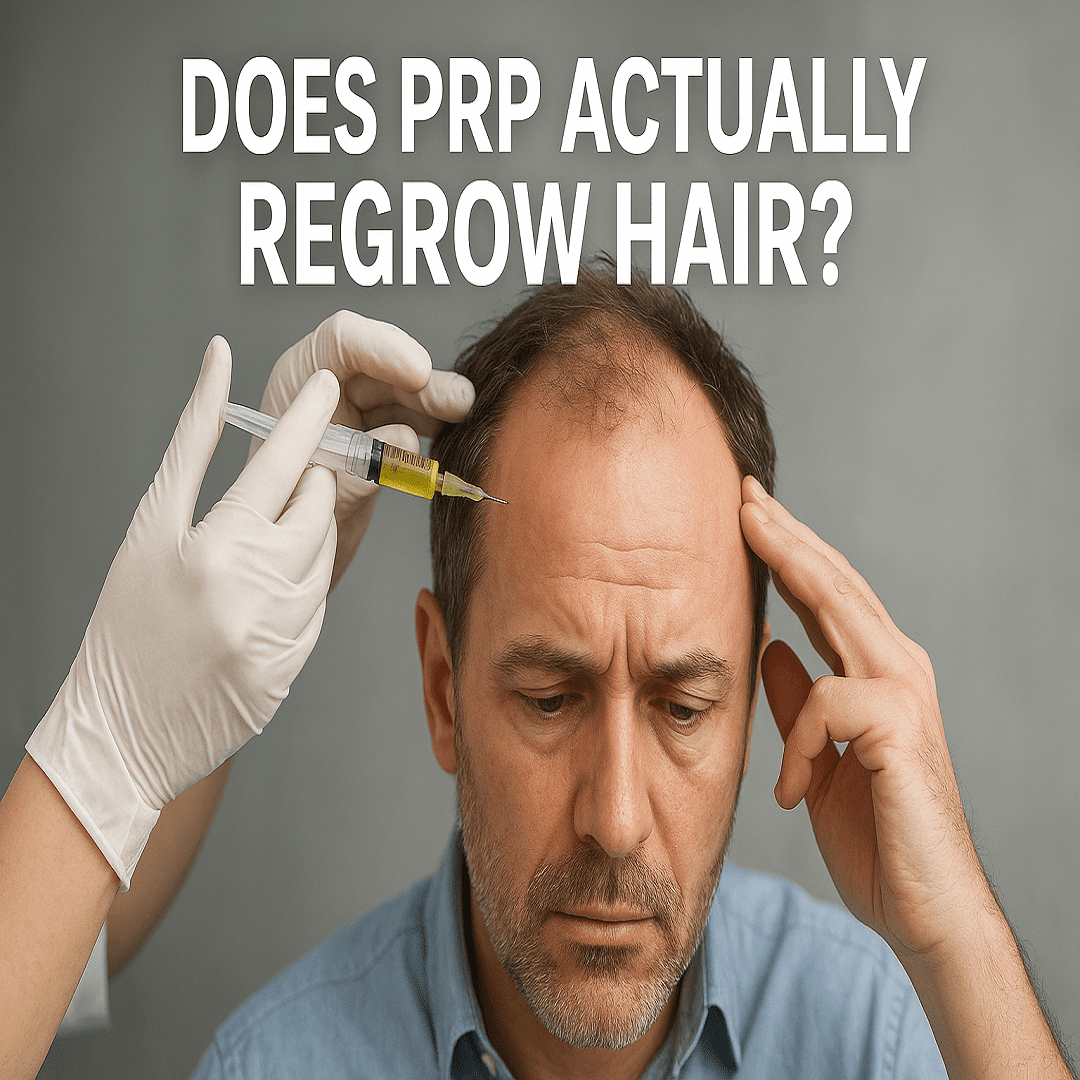Hair loss is a common concern that affects millions of people worldwide. It can impact self-esteem and change how we see ourselves. While countless products promise to restore thinning hair, one medical treatment has gained significant attention: Platelet-Rich Plasma (PRP) therapy for Hair Loss . But does it live up to the hype? This article will explore the science behind PRP, its effectiveness for hair regrowth, and what you can expect from the process.
We will look at clinical studies, expert opinions, and the real-world results people are seeing. By examining the pros, cons, and ideal candidates, you can gain a balanced perspective on whether PRP is a viable solution for your hair loss concerns.
Understanding the Science of PRP Therapy
To understand if PRP works, we first need to know what it is. Platelet-Rich Plasma is a concentration of platelets sourced from your own blood. These platelets are not just for clotting; they are a powerhouse of growth factors and proteins that play a crucial role in the body’s natural healing and regeneration processes.
The core idea behind PRP therapy for hair loss is that by injecting this concentrated plasma directly into the scalp, we can stimulate dormant or underperforming hair follicles. These growth factors are thought to “wake up” the follicles, improve blood flow to the scalp, and encourage the growth of new, thicker hair shafts. Essentially, the treatment aims to use your body’s own healing abilities to reverse the miniaturization of hair follicles often seen in common types of hair loss.
How Does It Target Hair Follicles?
Hair growth occurs in cycles: a growth phase (anagen), a transitional phase (catagen), and a resting phase (telogen). In conditions like androgenetic alopecia (pattern baldness), the growth phase shortens, and the follicles shrink, producing finer and shorter hairs until they stop producing hair altogether.
PRP is believed to work by:
- Prolonging the Anagen Phase:The growth factors in PRP may extend the growth phase of the hair cycle, allowing hair to grow longer and thicker.
- Increasing Blood Supply:PRP can promote the formation of new blood vessels around the hair follicles, a process known as angiogenesis. A better blood supply means more oxygen and nutrients reach the follicles, supporting robust growth.
- Reducing Inflammation:Some types of hair loss are associated with inflammation. PRP has properties that can help reduce this inflammation, creating a healthier environment for hair growth.
The PRP Treatment Process: What to Expect
The procedure for PRP hair therapy is relatively straightforward and is typically performed in a clinic. It involves three main steps.
- Blood Draw:A small amount of blood, similar to what you would give for a routine lab test, is drawn from your arm.
- Centrifugation:The blood sample is placed into a machine called a centrifuge. This device spins the blood at a high speed to separate its components: red blood cells, platelet-poor plasma, and platelet-rich plasma.
- Injection:The concentrated platelet-rich plasma is carefully extracted and then injected into the areas of the scalp where hair thinning is most prominent. A topical anesthetic may be applied beforehand to minimize any discomfort.
The entire process usually takes about 60 to 90 minutes. Most treatment plans involve an initial series of sessions, often spaced four to six weeks apart, followed by maintenance treatments every six to twelve months to sustain the results.
Is PRP Effective? A Look at the Evidence
The central question remains: does it actually work? The answer is complex, as results can vary significantly from person to person. However, a growing body of clinical research provides encouraging evidence.
Several studies have shown positive outcomes for individuals with androgenetic alopecia. For example, some research indicates that PRP therapy can lead to an increase in hair density, hair count, and the thickness of the hair shaft. Patients often report less hair shedding and a noticeable improvement in scalp coverage after a series of treatments.
One review of clinical studies concluded that PRP therapy appears to be a promising treatment for pattern hair loss, with many patients experiencing a significant increase in hair density. However, the authors also noted that treatment protocols are not standardized across clinics, which can lead to variability in results. This lack of a universal standard is a key challenge in the field.
Expert opinion is generally positive but cautious. Most dermatologists and hair restoration specialists in Tomball,TX agree that PRP can be an effective tool, particularly when used for the right candidate and at the right stage of hair loss. It is most effective for individuals experiencing early to moderate hair thinning, as it works by revitalizing existing but weakened follicles, not by creating new ones.
Who is the Ideal Candidate for PRP Therapy?
PRP is not a one-size-fits-all solution. Its success depends heavily on the individual’s specific condition and health. The best candidates for PRP hair therapy typically are:
- Individuals with Androgenetic Alopecia:This is the most common type of hair loss (pattern baldness) and the condition most studied in relation to PRP.
- People in the Early Stages of Hair Loss:PRP works best on follicles that are dormant or shrinking, not ones that are gone completely. The earlier the intervention, the better the potential outcome.
- Those with Sufficient Platelets:Since the treatment uses your own blood, you need to be in good general health with a normal platelet count.
- Patients Looking for a Non-Surgical Option:For those who are not ready for or do not qualify for hair transplant surgery, PRP offers a less invasive alternative.
Conversely, PRP may not be suitable for individuals who have been completely bald in an area for many years, as the follicles may be too far gone to be revived. It is also generally not recommended for people with certain medical conditions, such as blood disorders, active infections, or autoimmune diseases.
The Pros and Cons of PRP for Hair Regrowth
Like any medical treatment, PRP has its advantages and disadvantages. Weighing these can help you decide if it’s the right path for you.
Pros:
- Minimally Invasive:The procedure involves only injections, with no surgery or significant downtime required.
- Uses Your Own Biological Material:Since the plasma comes from your own body, the risk of allergic reactions or rejection is virtually nonexistent.
- Relatively Safe:When performed by a qualified professional, the procedure is considered very safe with a low risk of serious side effects.
- Natural-Looking Results:The goal of PRP is to stimulate your own natural hair growth, leading to results that look and feel authentic.
Cons:
- Cost:PRP therapy is not typically covered by insurance and can be expensive. A single session can cost hundreds to over a thousand dollars, and multiple sessions are needed.
- Variable Results:Effectiveness is not guaranteed. Some people see dramatic improvements, while others may experience only modest changes or none at all.
- Requires Maintenance:The results are not permanent. To maintain the benefits, you will need to return for follow-up treatments periodically.
- Potential Side Effects:While generally safe, minor side effects can include pain or soreness at the injection sites, swelling, headache, and temporary shedding of hair.
The Final Verdict: Is PRP a Worthwhile Investment?
So, does PRP actually regrow hair? The evidence suggests that for many people, the answer is yes. It can be an effective treatment for slowing hair loss and increasing hair density, especially for those in the early stages of pattern baldness. By harnessing your body’s own regenerative capabilities, PRP offers a promising, non-surgical approach to hair restoration.
However, it is not a magic cure. Success depends on selecting the right candidate, using proper techniques, and having realistic expectations. The cost and need for ongoing maintenance are significant factors to consider.
If you are exploring options for hair loss, the best first step is to consult with a board-certified dermatologist or a hair restoration specialist. They can accurately diagnose the cause of your hair loss, determine if you are a good candidate for PRP, and discuss all available treatment options. With professional guidance, you can make an informed decision and find a solution that helps you feel confident and in control of your hair health.































